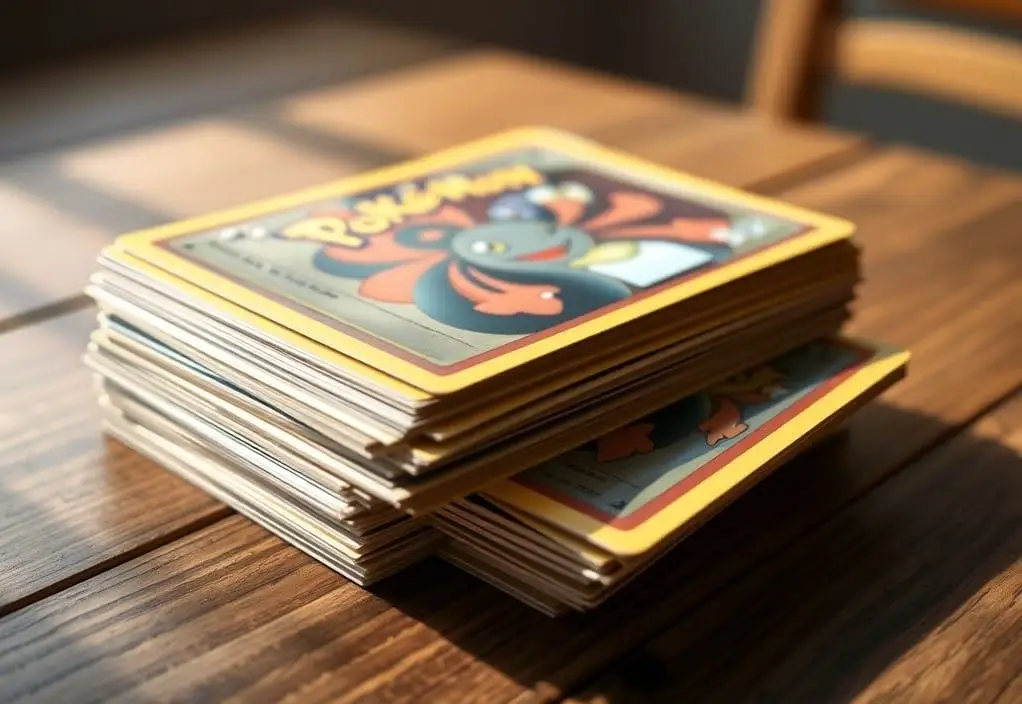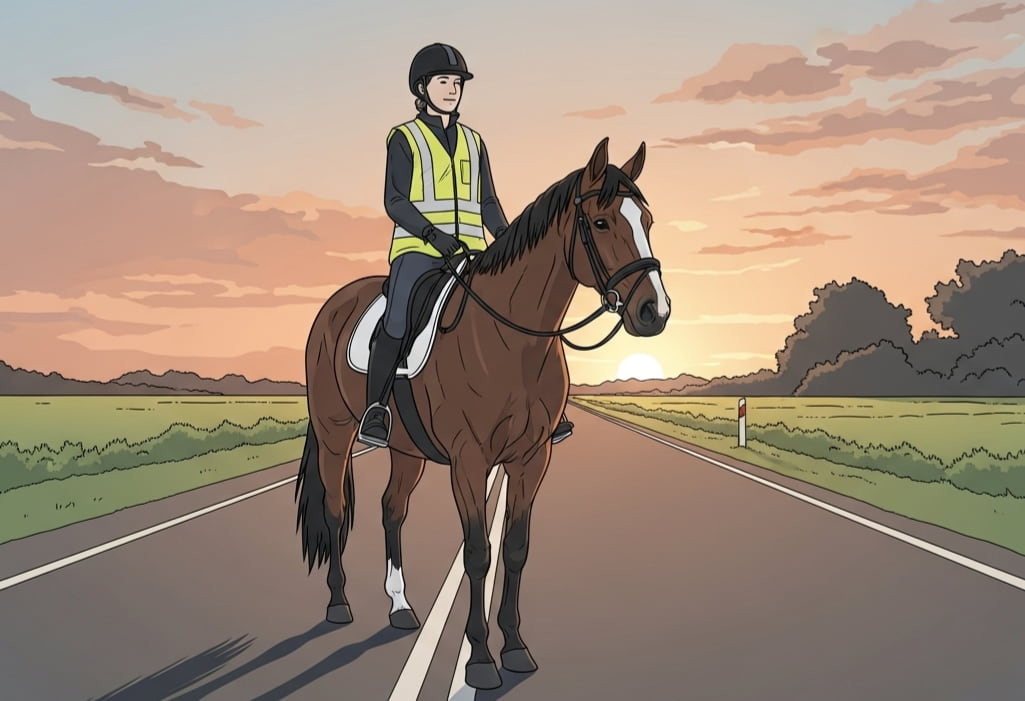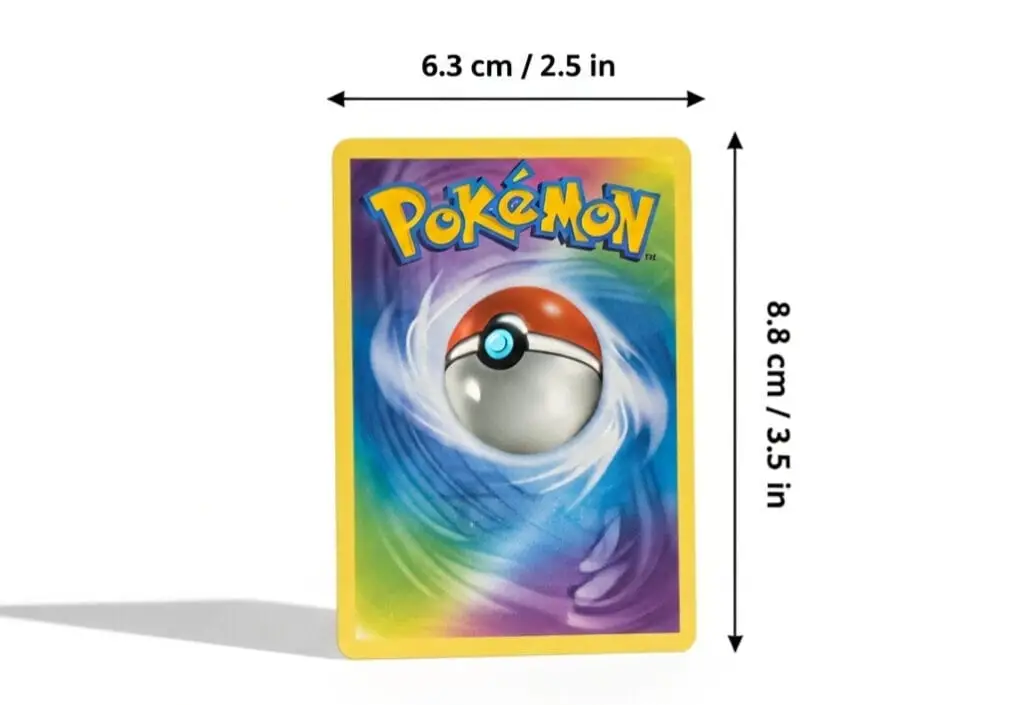Pokémon cards are not printed on A35 thick standard stock. Most official Pokémon cards are produced on layered stock that measures around 0.25 to 0.30 millimeters in thickness and includes a black paper core for durability and opacity. By comparison, A35 thick standard is closer to 0.35 millimeters and has no paper core, which makes it heavier and more rigid than the cards you pull from a booster pack. If you have ever wondered whether Pokémon cards match the A35 material, the answer is simple: they do not.
The difference matters because thickness and core construction change how a card feels in your hand, how it shuffles, and how durable it is over the years of play. Many collectors and designers look at cardstock options like A35, M31 linen, or P10 plastic when they want to print custom decks or compare them with trading cards like Pokémon.
1. What is A35 Thick Standard Card Stock
A35 thick standard is one of the heaviest paper stocks used in custom card production. Offered by companies like MakePlayingCards (MPC) and BoardGamesMaker (BGM), this stock is known for being stiffer than most game card materials. At roughly 0.35 millimeters, it is thicker than common trading card stock. Unlike black core or blue core paper used in trading cards, A35 has no core layer. This lack of a core makes the card denser in the hand, but also slightly more transparent when held up to strong light.
People choose A35 when they want cards that feel premium, last longer under frequent handling, or carry special designs like tarot decks or collector editions.
When compared with standard Pokémon card stock, the differences stand out clearly:
- Pokémon cards: thinner (0.25–0.30 mm), flexible, and fully opaque due to their black paper core.
- A35 stock: thicker (0.35 mm), bulkier, more rigid, and semi-transparent without a core layer.
This is why A35 is rarely chosen for trading card games like Pokémon, where shuffle feel, flexibility, and opacity are more important than extra thickness.
2. How Thick is a Standard Pokémon Card
A standard Pokémon card measures about 0.25 to 0.30 millimeters in thickness. This puts it in line with most trading card games such as Magic: The Gathering and Yu-Gi-Oh. The material is usually a layered paper stock with a black or blue core that prevents light from passing through, which protects against counterfeiting and gives the card a professional finish, with full specifications detailed in Pokémon card dimensions.
When you stack a deck of 100 Pokémon cards, the total height comes out close to 25 millimeters. That simple measurement confirms the average thickness of each card. By contrast, a deck of 100 cards made from A35 stock would be closer to 35 millimeters tall. The extra thickness may not sound like much until you shuffle or handle a large deck.
The difference becomes clear in play:
- Pokémon cards: thin, flexible, shuffle smoothly, but need protective sleeves to avoid edge wear.
- A35 stock: thick, rigid, holds shape well, but feels bulky and resists natural shuffling.
This balance between lightness, flexibility, and durability is exactly why Pokémon cards are designed with their specific stock. It makes them practical for long play sessions while still requiring protection for serious collectors.
3. How Thick is Standard Card Stock
Standard card stock varies depending on how it is measured. In most printing industries, thickness is described in points or millimeters. One point equals one thousandth of an inch. Common options for cardstock range from 10 point (about 0.25 millimeters) to 12 point (about 0.30 millimeters). This is the same range where trading cards like Pokémon usually fall.
For everyday printing, standard card stock such as 300 grams per square meter (gsm) is popular because it balances flexibility and strength. While GSM measures weight rather than exact thickness, in practice, 300 GSM stock feels very similar to 10–12 point card stock. Anything lighter tends to feel flimsy, while anything heavier, like 350 gsm or more, starts to feel rigid and closer to A35.
In simple terms:
- A business card printed on 300 gsm stock feels very close to a Pokémon card.
- A postcard or thick invitation printed on 350 gsm stock is closer to A35.
Standard Pokémon card thickness, around 300 gsm or 10–12 point, offers the balance of flexibility and durability that trading cards need.
4. What Cardstock are Pokémon Cards
Pokémon cards are printed on layered paper stock around 300 gsm with a black core (sometimes referred to as blue core in the printing industry). The black core keeps the Card fully opaque and adds durability. The surface is smooth with a light gloss that protects colors and artwork.
When compared with A35 stock, the differences are clear:
- Pokémon cards: thinner, flexible, opaque, and designed for smooth shuffling.
- A35 stock: thicker, heavier, rigid, and semi-transparent without a core.
This design makes Pokémon cards practical for long play sessions while still maintaining the professional print quality collectors expect.
5. How A35 Stacks Up vs Common Alternatives
- Standard Pokémon Card Stock: About 0.25 to 0.30 mm. It is layered with a black core, flexible, fully opaque, and easy to shuffle.
- A35 Thick Standard: About 0.35 mm. It is rigid, has no core layer, feels heavier, and can appear semi-transparent under strong light.
- M31 Linen: Similar in thickness to Pokémon stock. It has a linen texture that adds grip and gives a more premium look.
- P10 Plastic: Around 0.33 mm. It is fully plastic, waterproof, very durable, but has a less natural paper feel.
Overall, A35 is the thickest and heaviest option. Pokémon card stock is closer to M31 or other standard core stocks used in trading card games, designed to balance flexibility, opacity, and durability for consistent play.
6. Different Card Stocks and How They Feel
M31 Linen Card Stock: Casino-grade paper stock with a linen texture. Similar in thickness to Pokémon cards but with added grip and a more premium feel.
Best Cardstock for Playing Cards: Typically 300 to 330 gsm with a black core. This range balances durability and flexibility, which is why it is the closest match to official Pokémon cards.
P10 Plastic Card Stock: Made from 100 percent plastic, about 0.33 mm thick. It is waterproof and long-lasting, but the feel is different from the paper-based stock used for Pokémon cards.
Playing Card Paper Type: Most trading cards, including Pokémon, are printed on multi-layered paper with a black or blue core, usually in the 280 to 330 gsm range.
MPC Card Stock: MakePlayingCards (MPC) offers several options, such as smooth, linen, and thicker materials like A35. These are often chosen for custom projects but differ from Pokémon’s official stock.
BGM Linen Card Stock: BoardGamesMaker’s version of linen stock. It is similar to M31 but marketed for custom game projects rather than trading card games like Pokémon.
Playing Card Finishes: Common finishes include smooth, gloss, and linen texture. Pokémon cards typically use a smooth surface with light gloss to protect artwork while maintaining shuffle ease.
Among these options, Pokémon cards most closely align with standard 300–330 gsm black core paper with a smooth or lightly glossy finish, designed to balance playability and durability.
7. What You Should Know Before Picking Card Stock
If you want cards that feel closest to Pokémon, choose stock around 300 gsm with a black core. This gives the same balance of flexibility and durability found in official Pokémon cards.
Pick A35 only if you want a premium, rigid deck for collector editions, tarot cards, or specialty products where thickness adds value. Keep in mind that thicker cards increase the overall height of a deck, which can also affect packaging.
For waterproof or outdoor use, plastic stock such as P10 is a better choice. At around 0.33 mm, it is fully plastic and long-lasting, but the feel is different from paper-based trading cards. For a professional shuffle feel, linen finishes like M31 or BGM work well, adding grip and a more premium touch.
Always test a sample deck before committing to a full print run so you know exactly how the cards will feel in play. Ultimately, the right choice depends on whether you value playability, durability, or premium presentation.
Conclusion
Pokémon cards are printed on stock that averages 0.25 to 0.30 millimeters in thickness, while A35 thick standard measures about 0.35 millimeters and feels noticeably heavier. This difference explains why Pokémon cards are easier to shuffle and handle, while A35 comes across as bulkier and more rigid. For a comprehensive guide on Pokémon card sizes and weights, you can refer to this Pokémon card size and weight guide.
To achieve the feel of authentic Pokémon cards, choose a black core stock close to 300 gsm. For projects that call for a stiffer and more premium presentation, A35 is a valid option, although it changes how a deck handles in play.
By understanding these options, you can select the right material for your needs, whether you are a collector protecting your cards, a player looking for smooth gameplay, or a designer planning a custom project. Making the right choice ensures your cards look authentic and perform the way you expect.
Frequently Asked Questions
What is A35 thick standard card stock?
A35 thick standard is premium card stock around 0.35 millimeters, rigid, and coreless. It is heavier than most trading card stock.
How thick is a standard Pokémon card
Standard Pokémon cards measure roughly 0.25 to 0.30 millimeters with a black or blue core for opacity and durability.
How thick is standard cardstock
Most standard card stock ranges from 0.25 to 0.30 millimeters (10–12 pt), similar to trading cards like Pokémon.
What cardstock are Pokémon cards
Pokémon cards use layered paper stock with a black or blue core and a smooth, light-gloss finish to protect the artwork.




